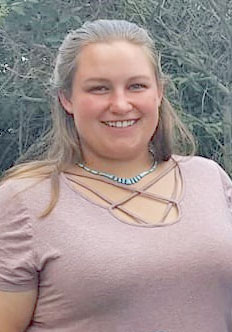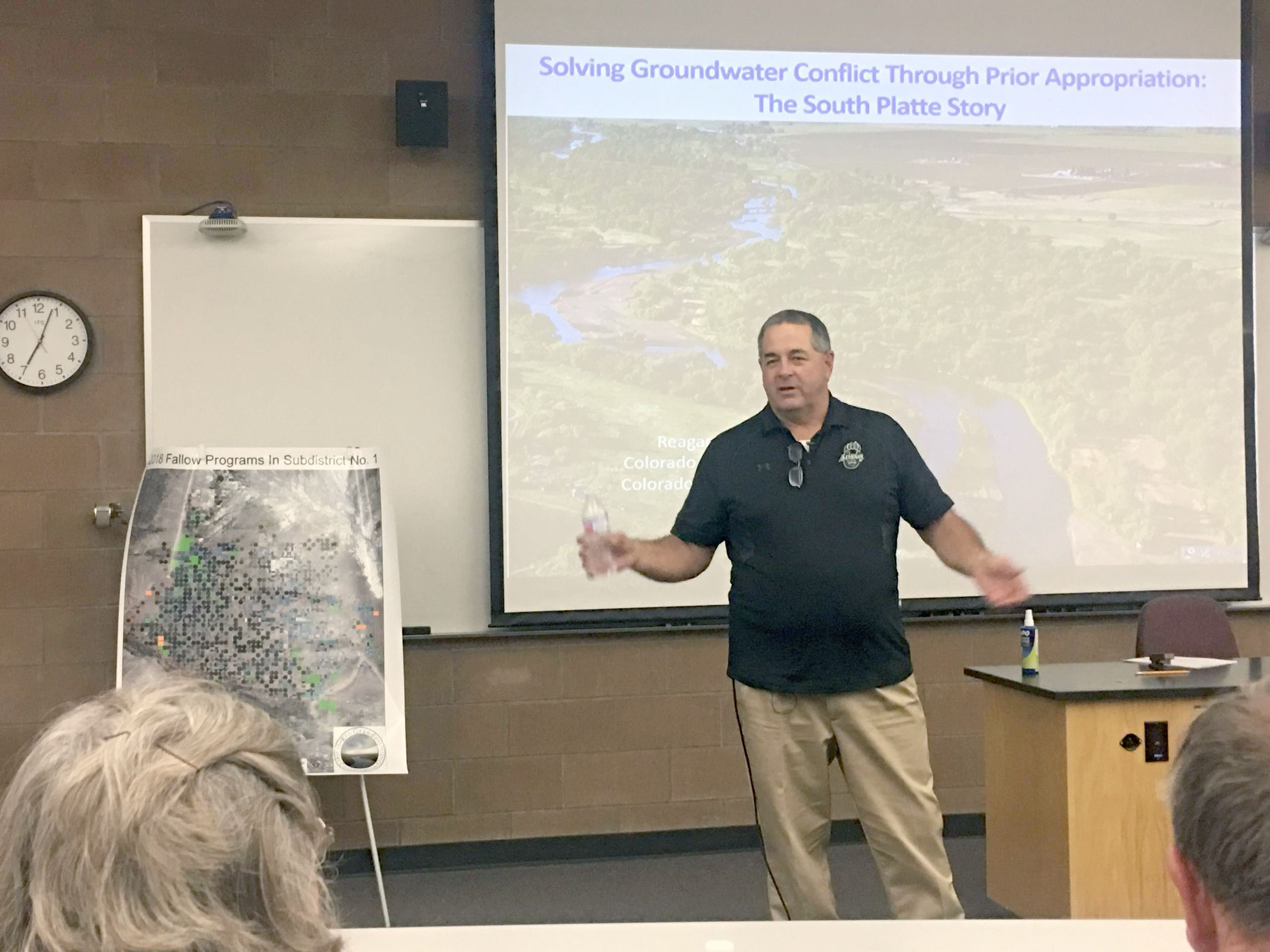ALAMOSA - From her family’s farm near Mosca, Erin Nissen can see the Great Sand Dunes in the distance. Whether through a window or from the porch, the towering 700-hundred-foot ridges of sand are always in view, a constant reminder of what she fears may come.
“That’s how we could end up if we’re not careful,” the fourth-generation farmer says. “If we keep on draining the aquifer like we’ve been, our farm could end up being nothing but sand.”
Nissen, 30, has reason to be anxious. Drought and excessive pumping by some farmers have drained water levels in the aquifer to an almost unprecedented level, leaving the valley at a crossroads and local water officials faced with a decision that could put some farmers out of business.
Nissen runs Nissen Farms with her father, Lyle, whom fellow growers in the valley describe as being “head and shoulders above everybody else” when it comes to sustainable farming.
“Lyle was doing things 20 years ago that nobody was even thinking about,” says John Kretsinger, a farmer and rancher who bought land in Alamosa in 1989 because it had one of the most responsive aquifers in the country.
In the years before Kretsinger transplanted himself from Texas to Colorado, the valley was rich with farms growing a cornucopia of vegetables: Turnips, spinach, broccoli, carrots, lettuce. In the late 1940s, the valley produced enormous crops of peas with entire freight cars full trucked out every week.
Don Shawcroft is a 64-year-old rancher who runs cattle in Conejos County. His family came here in the 1800s, and the valley he remembers is a far cry from the valley he sees now:
“When I was a kid, there were some places where the ground was so marshy, you couldn’t ride a horse across. Water coming out of some of those wells that were dug early on would shoot straight up in the air and over the house. Those days are over. All that water has been pumped out of the ground.”

Erin Nissen of Nissen Farms. (courtesy)
Now, with only seven inches of rainfall per year and “barely half the groundwater that was available just a decade ago,” everything on the Nissen’s farm — every seed they plant, every decision they make — “is all based around water,” Nissen says.
Decisions like adding radish and green manure to the soil so it retains more moisture. And choosing crops based on how much water they will need and when they will need it. And tracking how much water the farm pumps, down to 0.08”, and recording that amount every single day. And, ultimately, calculating how much water they will be able to put back into the aquifer, whether through recharging ponds or other surface water, to replace what they have withdrawn.
“We’re doing different things all the time so we can keep cutting back. But it’s hard, and it’s getting harder,” Nissen says.
But what is hardest, she notes, is “when we see other farmers doing nothing.” Because what other farmers do is crucial to the Nissen’s operation.
Though father and daughter have complete control of their own farming practices, they are part of a group of 300 farmers bound together because their collective depletion of the aquifer is out of control.
Water bureaucracy can be a snoozer, as can hydrology. So, for the purposes of this story, suffice it to say that the group, called Subdistrict No.1, was formed as a political subdivision and corporate body in 2006 by holders of surface-water and ground-water rights in Alamosa County and parts of Rio Grande and Saguache counties — the heart of this alpine desert valley — specifically for the purpose of taking action to restore what’s called the “unconfined aquifer.” That’s the water table closest to the surface, which is not to be confused with the “confined aquifer” several layers deeper underground.
The gist of the collective — and why people far beyond the San Luis Valley and even Colorado state lines are watching it so closely — lies in the idea that, because there are too many farmers relying on a finite and ever-dwindling layer of groundwater in a time of prolonged drought and climate change, everyone using that water is inextricably tied.
About half of Subdistrict No. 1’s members are farmers who, like the Nissens, are committed to sustainable farming. The other half are not and continue to pump more water from the aquifer than what they return to it. No matter what members are growing or how they grow it, no matter if their families have worked the land for generations or if a farm or ranch was bought out last year by anonymous hedge funders, members of the subdistrict have united in hopes of keeping their water fate in local hands rather than in those of state water regulators, who have the power to shut down their wells.
The collective actions of Subdistrict No. 1 ultimately could have more of an impact on the future of the Nissens’ farm — or any other — than the actions of individual farmers themselves.
In Colorado, the dynamics of hydrology are not the only powers and factors farmers need to fear when they take more water out of the ground than they put back in. State government has authority, wielded through the Office of the State Engineer within the Division of Water Resources, to step in and shut off irrigation wells when farmers fail to live within their means. It is power the state will use.
During a severe drought in 2002, farmers in Adams, Weld and Morgan counties along the South Platte River were locked in a legal battle over farmers’ excessive use of groundwater for irrigation impacting the rights of farmers who relied on surface water to irrigate. The State Engineer stepped in and shut down wells — 8,000 of them — until farmers using groundwater could develop a plan to replace the water they had depleted, reducing injury to the senior surface water rights holders. The shut-offs were devastating to farmers and their communities. And for the owners of about 2,000 wells, the impact was permanent since the wells were never turned back on.
Three hundred miles to the southwest, farmers in the San Luis Valley watched the state’s response along the South Platte as it was unfolding in 2002, and what they saw was the writing on the wall. Groundwater regulations from the state were coming, and the levels of water in the aquifer, tracked since 1976, were of great concern. In the 2002 drought — the worst ever on record in the valley — withdrawals had caused an unprecedented decline of almost 400,000 acre feet. The levels continued to decline to almost 800,000 acre feet in 2006.
Cleave Simpson is a fourth-generation San Luis farmer and rancher and head of the Rio Grande Water Conservation District. As he tells it, his community realized the state could just as easily come in and shut down their wells, too, and that they had to find a way to collectively manage their aquifer.

Cleave Simpson, General Manager of the Rio Grande Water Conservation District.
(Courtesy)
“I can’t say what was in the heads of those farmers on the South Platte. I think they knew about their problem, but they didn’t act on it aggressively enough,” Simpson says. “We were determined to have a different outcome. We were going to find our own solution.”
That determination — and the decision to create the subdistrict in 2006 — was driven by two factors:
The formation of the subdistrict also stemmed from a core value among locals and most rural Westerners: that growers, not state bureaucrats, should be the ones to restore and manage the water beneath their feet.
The farmers leading the effort to create the subdistrict knew it wouldn’t be easy. Water agreements never are. The Rio Grande River — the primary source of the water that feeds the aquifers by seeping into the ground — was already over-appropriated more than a century ago with more water rights decreed than the river could support. Hydrologists at that time miscalculated the river’s normal flows, and to this day water experts are still learning about the complexity of the aquifers here.
The law of that river, called the Rio Grande Compact, further complicates things by requiring that Colorado deliver a certain amount of water flow to New Mexico every year. That agreement was signed in 1938 when the population and number of growing operations here were just a fraction of what they are now.
A drilling spree during the 1950s and 1960s led to the creation of thousands of wells and granting of individual water rights by the State Engineer, the same state agency that would start shutting some of those wells down 40 years later.
For some farmers, short-term, high-commodity prices overrode the long-term necessity to use less water as climate change was affecting water supply in unforeseeable ways.
Creating a subdistrict was local farmers’ only way of buying themselves more time. The state agreed to let them continue drawing from the aquifer on the condition that they replenish the water to a certain level by 2031. Should the subdistrict fail to reach that target, the State Engineer’s Office — whose staff closely monitors water levels and tracks the subdistrict’s plans for restoring them — will shut down their 3,000 wells until the aquifer reaches that level on its own.
The subdistrict’s plan is crafted unlike any other in the state. “Subdistrict number one is the first experiment in sustainability where we don’t just mine the resource,” says Mike Sullivan, deputy director of the Division of Water Resources. Mining the resource — another way of saying mining to extinction — is solely focused on extraction and managing water to last for a longer period of time with no focus on putting water back into the aquifer. “Subdistrict one’s plan is the only one I know of anywhere that’s focused on sustainability and achieving the long-term goal of living within our means, which is the only way agriculture will last into the future.”
That leaves local farmers, at least those actively paying attention, regularly checking a graph https://rgwcd.org/images/Wells/Change_in_Unconfined_Aquifer_Graph_1.pdf on the Rio Grande Water Conservation District’s website that tracks the subdistrict’s progress toward that target. When the line shows the aquifer’s water level going up, they feel hopeful. When the line goes down, hearts sink with fears of state regulators showing up to shut off their wells.
This is new territory in terms of state regulation. State Engineer Kevin Rein has not tipped his hand on whether his office will wait until 2031 to take action, or do so sooner if the line on the water graph isn’t heading in the right direction quickly enough.

Trudi and John Kretsinger of KW Farms.
(Courier photo by Priscilla Waggoner)
Kretsinger recalls a conversation years ago when he asked an official in the State Engineer’s Office whether it might give farmers some leeway if they’re not making fast enough progress. The official pointed to the water pump where they were standing by. “Do you see a mitigation switch on there? No, you don’t because there are only two switches. One for on and one for off. That’s how we mitigate.”
As Marisa Fricke, who manages the subdistrict, tells it, local farmers knew “better than anyone what was happening to the water levels.” Most, she says, “knew something had to be done, and they knew the state would do something if they didn’t.”
Most, but not all.
Some reluctant subdistrict members still believe their 50- and 60-year-old drilling permits guarantee them the right to a certain amount of water, regardless of what direction the line on the graph is heading. It hasn’t been easy for growers who are still farming the way their dads and granddads did — and for those lured by temporarily high commodity prices — to reduce their water use by changing their ways.
Lawsuits have been filed. Conflicts have erupted between those who farm by flooding their fields and those who irrigate with center pivots. Owners of smaller, less profitable farms have complained they’re more at risk than owners of bigger farms with deeper pockets.
“There weren’t many kumbaya conversations,” Kretsinger says. “Things got pretty tense. Nobody ever swung a punch, but voices were raised — quite loudly, at times.”
It took until 2011 for Subdistrict No. 1 to become fully operational. The group is governed by farmers elected to a board by other farmers and has committed to a plan that relies on the law of economics to govern individual behavior.
At first, farmers who drew more water for irrigation than what they put back were assessed an over-pumping fee of $45 per acre foot, (An acre foot is equal to a sheet of water one acre in size that is also one foot deep, and is about the amount that would support three to four families for a year.)
Some farmers were paying the fee for just one or two acre feet, Fricke says, but others who kept up their old habits of drawing more than they put in were paying from $50,000 to $300,000 each growing season.
Despite persistent drought, water levels began to recover during the first few years. But, because many of the members continued to draw more than they were putting back, the subdistrict raised fees to $75 an acre foot in 2012. The line on the graph, with some bumps along the way, slowly continued to head upward, causing Simpson and others to be hopeful.
But then came 2018. Severe drought conditions plus low snowpack wiped out three years of progress in that single year. The line on the graph plummeted, showing the aquifer was almost a million acre-feet below target. That prompted a warning from the state engineer stating he recognized all the work the farmers had done, but that his office may not wait until 2031 to shut down the wells if the line in the graph didn’t head upward quickly.
“I may have to do something that will make your lives very hard,” Kevin Rein told the group who had gathered for an in-person meeting that year.
The subdistrict’s board voted to raise over-pumping fees to $90 per acre foot.
The following year, 2019, was, according to Fricke, a “fabulous year for moisture” and everyone expected that some of the water that had been lost would be partially recovered. But farmers and hydrologists alike were shocked when measurements in the aquifer showed little improvement.
That prompted a threatening letter from the state engineer in 2020. The subdistrict’s board raised over-pumping fees to the current level of $150.
In ten years, the subdistrict has collected more than $70 million in fees, which it has used to financially reward members who are doing the most to conserve. Money has also been used to buy private water rights, pay for farmers to temporarily let their land go fallow, and to take acreage permanently out of production.
But, at least so far, the $150 over-pumping fee has not been high enough to force the level of conservation that’s needed. The subdistrict now has a decade to replenish the aquifer with 900,000 acre feet of water — the amount of water that serves all of the residences in Denver for six years.
“It’s hard to wrap your head around how much water that is,” says Travis Thompson, communications manager with the Denver Water Board.
That challenge brings the subdistrict to a crossroads.
The subdistrict’s board is poised in mid-2022 to vote on raising the over-pumping fee from $150 to $500 per acre foot. The 233% increase, if approved, would up the ante so much that most farmers wouldn’t be able to afford over-pumping. Raw economics would either force them to cut their water use or go out of business.
As drought deepens, climate change intensifies and the aquifer’s water level continues to drop, San Luis Valley’s grand, one-of-a-kind experiment of collective self-governance is shaping up like an extremely high-stakes game of sustainable-farming “Survivor.”
If the state does not intervene and shut down wells before 2031 — a very big if — the Nissens and other early adopters of hard-core conservation will be far more likely to stay in business long term. Others, temporarily buoyed by commodity prices that enable them to pay much higher fees for excessive water usage, will not if those prices fall.
But if the state, not seeing enough progress, shuts wells off before 2031, the game could be over for everyone.
“The subdistrict is just doing what it was created to do,” Shawcroft says in defense of the proposed $500 over-pumping fee. “This valley relies on agriculture, and agriculture relies on water. If that water is shut off – or worse, used up - none of these towns will survive.”